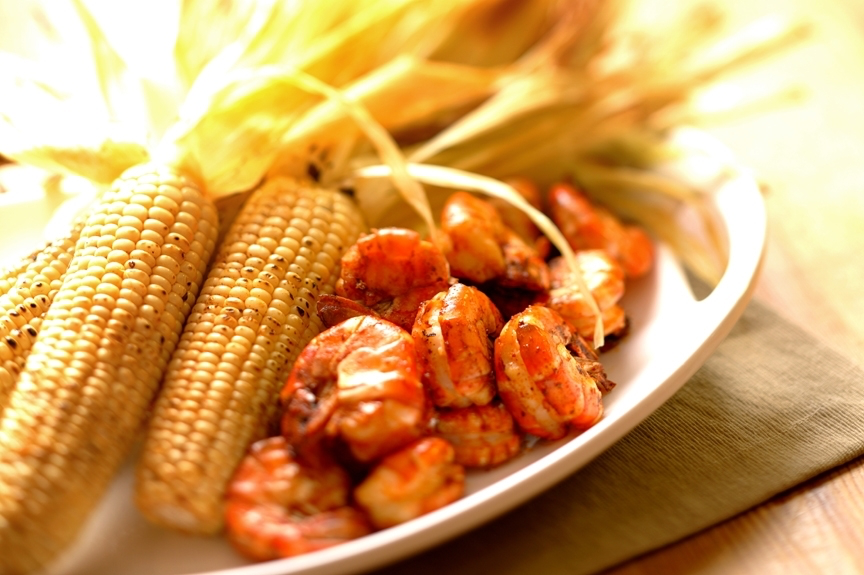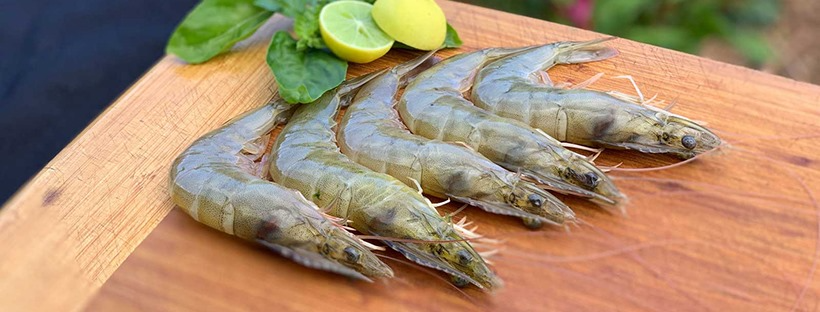
A summer favorite of mine, this Cajun marinade of garlic, lemon, paprika, cayenne, cumin, and thyme PACKS the shrimp with flavor. I love to pair it with grilled corn dusted with cumin and chili powder butter – delicious!
HOW TO FIND SUSTAINABLE SHRIMP
Finding sustainably raised or caught shrimp can seem like a challenge. The United States imports around 90% of the shrimp that we eat!
When looking for sustainable options, examine the packages in the frozen seafood case or ask the fishmonger where the shrimp is from – you’ll discover that the majority comes from aquaculture operations in places such as Mexico, Ecuador, Southeast Asia, China, and India.
Thankfully, with the help of organizations like Best Aquaculture Practices and Monterey Bay Aquarium’s Seafood Watch Program, you can find an incredible amount of well-raised or sustainably harvested shrimp.
Keep an eye out for giant freshwater prawns farmed in Central and South America and giant tiger prawns from Selva Shrimp Verified Farms in Southeast Asia, which are rated green for “Best Choice.” Kauai Shrimp, a farm on the west shore of the island of Kauai, is also rated “Best Choice.”
“Good Alternatives” (the yellow rating from Seafood Watch) include white leg shrimp from ponds from Ecuador and Honduras, white leg shrimp grown in infrequent exchange ponds from Thailand, and giant freshwater prawns from Asia.
For wild-caught shrimp, look for spot prawns (aka spot shrimp) and two other closely related coldwater shrimp: the sidestripe and the coonstripe (both of which may be marketed as spot shrimp or prawns). These are caught on the Pacific Coast, primarily from Washington to Alaska, and have minimal conservation concern – the Monterey Bay Aquarium Seafood Watch program considers them all “Best Choices.”

In addition, here’s a guide to the various labels and descriptions for the shrimp and what they mean:
Marine Stewardship Council – This indicates that the wild shrimp are caught using sustainable fishing practices, which can include outfitting nets with devices that allow other animals to escape.
Aquaculture Stewardship Council – This indicates that the shrimp are raised without antibiotics and according to guidelines that protect the environment. This label also ensures that shrimp farms do not use forced labor. However, the guidelines permit the use of certain chemicals, including some pesticides, and don’t limit the number of shrimp in a pond.
Whole Foods Market Responsibly Farmed – Certifies that shrimp are raised in conditions that protect the environment, without antibiotics, and with limited use of chemicals. However, there’s no limit on the density of shrimp in ponds. This label is found only at Whole Foods Market stores.
Environmentally Aware – An easy claim to make, but it’s not backed by a consistent set of standards to ensure that shrimp were sustainably caught or farmed.
Natural – This term has no official definition for shrimp – ignore it.
No Antibiotics – On meat and poultry, this term means what it says, but when it comes to shrimp, the term is not defined by the FDA.
No Hormones – There is no government or official definition for this term on shrimp. Hormones are never used in the farming of shrimp.
Organic – There is no approved standard for organic seafood in the U.S. – be wary of shrimp with this claim.
Sustainable – There is no regulated definition of “sustainable.” Any seller can make this claim, but should have back up for making this claim, such as the “Good Alternative” or “Best Choice” rating from Seafood Watch.
Turtle Safe – This claim is not backed by a consistent set of standards.
GRILLED CAJUN SHRIMP
Makes 6 servings
- 1/4 cup olive oil
- 2 teaspoons chopped garlic (2 medium cloves)
- 1 tablespoon fresh lemon juice (from 1 medium lemon)
- 2 teaspoons paprika
- 1/4 teaspoon cayenne pepper
- 1/4 teaspoon ground cumin
- 1/4 teaspoon dried thyme
- 2 pounds large sustainably raised or caught shrimp (21-30 per pound)
1. Melt the butter in a small skillet over medium heat. Add the garlic and cook, stirring occasionally, until soft, 2 to 3 minutes. Remove from the heat and add the remaining marinade ingredients. Stir and allow the liquid to cool at room temperature.
2. Using a sharp knife, split open the back of each shrimp and remove the black vein.
TIP – If you are in a hurry, look for the easy-peel shrimp that are often available in your supermarket. The shells have already been slit and the vein has been removed. I generally rinse lightly, drain well, and then just add them to the marinade – nothing to it!
3. Place the shrimp in a large, resealable plastic bag and pour in the marinade. Place the bag in the refrigerator and marinate for 20 minutes.
4. Preheat the grill to high heat. Remove the shrimp from the bag and discard the marinade. Grill until the shrimp are pink or orange and are firm to the touch, about 2 to 4 minutes, turning once halfway through grilling time. Remove from the grill and serve warm or at room temperature with couscous, if desired.
GRILLED CORN WITH CUMIN BUTTER
Makes 6 servings
- 6 ears of corn, in the husk
- 3 tablespoons butter, room temperature
- 1 teaspoon ground cumin
- 1 teaspoon chili powder, or more to taste
- Salt and freshly ground pepper, to taste
1. Heat the grill for 5 to 10 minutes to medium heat. Carefully peel back the corn husk, but do not detach it. Remove all of the corn silk.
2. In a small bowl, combine the butter, cumin, and chile powder. Pull the husk back, and tie it with kitchen twine.
3. Arrange the corn on the grill. Cook, turning frequently. Don’t worry if the husk gets charred and burned. The kernels will steam and be moist and tender when it’s done. Cut off the strings, remove the husks, and serve.
TIP – If you know that the corn is several days old, soak it in a mixture of sugar and water for one hour. Towel dry, rub with butter, tie with twine, and grill.
